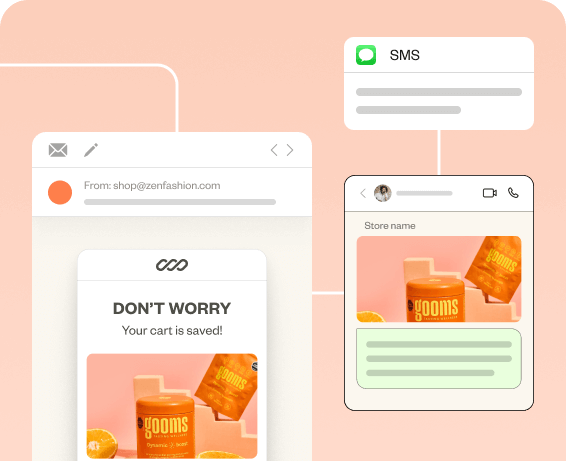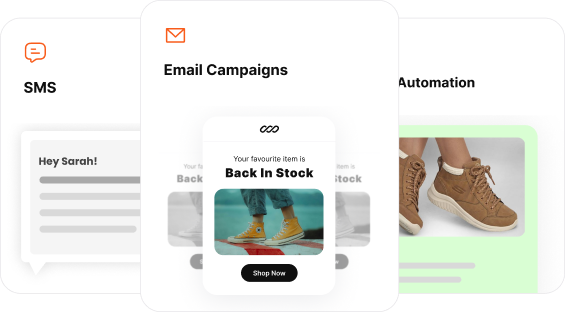Email segmentation and personalization work in tandem to make email marketing targeted.
But here’s the catch: most marketers blur the lines between the two. They lump them together like they’re the same thing. They’re not.
In this blog, we’ll break it down. We’ll explore what is the difference between email segmentation and personalization, how they work, and – more importantly – how they work together to create targeted email marketing.
Let’s dive in.
Segment your customers and personalize emails in a few clicks with Retainful.
What is email segmentation and its types?
Email segmentation is the practice of dividing your email subscribers into smaller, more specific groups based on shared characteristics, behaviors, or preferences
Rather than sending the same generic email to your entire list, segmentation allows you to target specific subsets of your audience with content that resonates more personally with them.
Common Types of Email Segmentation
- Demographics – Grouping subscribers based on demographic factors like age, gender, income level, marital status and more.
- Purchase History – Using customer buying data to create groups based on: past purchases, frequency of purchases and spending habits.
- Engagement Behavior – Grouing subscribers by how they interact with your emails and content like open rate, click rate, and inactive subscribers.
- Lifecycle – Based Segmentation – Grouping customers by their stage in the customer journey – new, active, loyal, or dormant
- Psychographic segmentation – Going beyond surface-level behaviors by focusing on the deeper motivations, interests, and attitudes of your customers.
What Is Email Personalization?
Email personalization is the practice of tailoring email content to individual recipients based on their specific data, preferences, and behavior.
For example:
- Instead of “Check Out Our New Collection,” you send “Hi Alex, New Arrivals You’ll Love Based on Your Recent Picks.”
- Rather than offering all subscribers the same product, you recommend items based on their browsing history.
Here is an example of email personalization about how it targets the customer segment of customers residing in America.
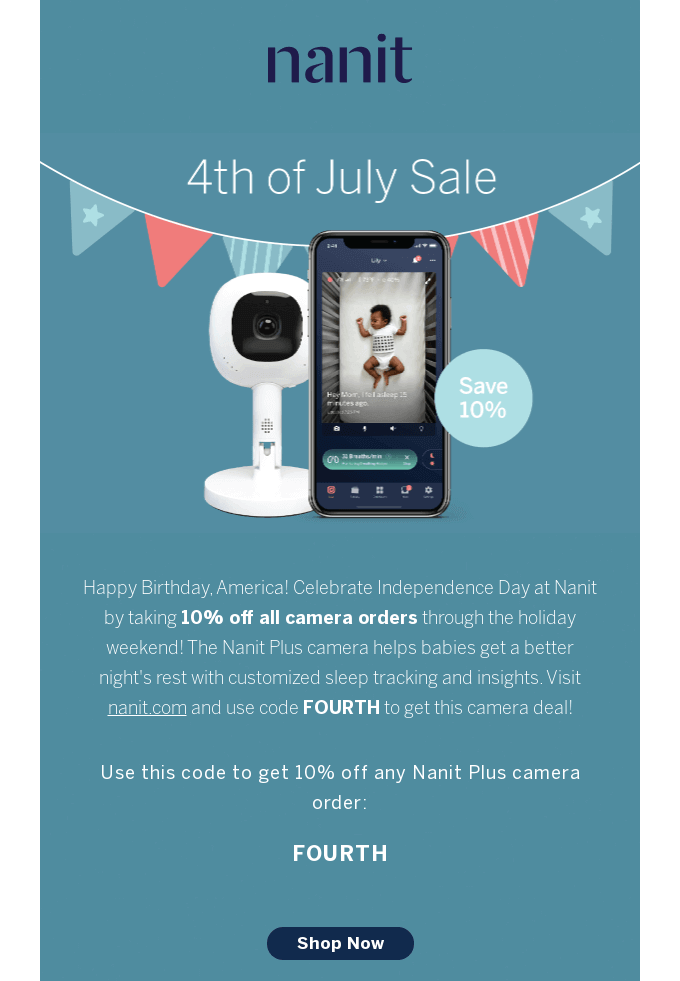
Comparing Email Segmentation and Personalization
The difference between email segmentation and personalization is that segmentation groups subscribers based on shared characteristics, while personalization customizes email content to address individual preferences, behaviors, and needs within those segments.
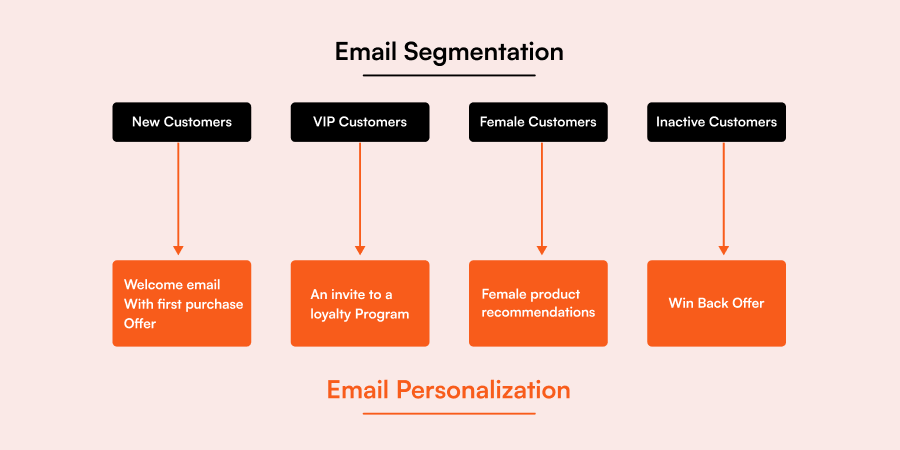
1. Based on how it is implemented:
Email Segmentation – Grouping Subscribers into Segments
Based on the collected data, subscribers are grouped into segments that reflect similar traits or actions.
For instance:
- A clothing retailer might create segments like “Frequent Buyers”, “Seasonal Shoppers”, and “New Subscribers”.
- A SaaS business might segment users as “Free Trial Users”, “Active Subscribers”, and “Churned Customers”.
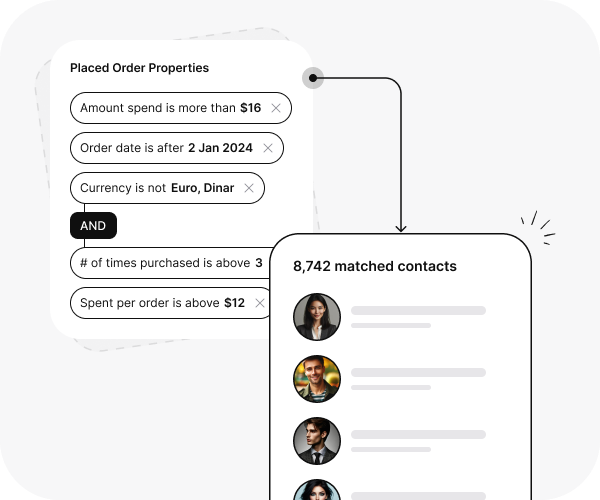
Email personalization – Customizing email content for grouped segments
Customizing the content of emails for the segmented groups using their unique data, such as their name, preferences, location, purchase history, and behavior.
Example:
- Personalizing Subject Lines
- Addressing Recipients by Name
- Dynamic Content Based on Preferences
- Personalized Product Recommendations
- Personalized Upsell or Cross-Sell Emails
2. Correlation between email segmentation and personalization
Segmentation Enables Personalization
Segmentation creates the foundation for email personalization.
While segmentation groups users into categories, email personalization takes it a step further by crafting targeted email content to resonate for each customer segment.
How to implement email segmentation and personalization?
Step 1: Choose an email segmentation tool
Step 2: Choose the criteria to segment subscribers
Step 3: Create email content for each customer segment
Step 4: Send the emails
Let’s see these steps in detail.
Step 1: Choose an Email Segmentation Tool
The first step in implementing email segmentation and personalization is selecting an email marketing platform that supports advanced segmentation features and personalization capabilities.
Ensure the tool allows you to segment subscribers by various criteria (e.g., demographics, behavior, purchase history) and supports dynamic content for personalization.
Example: In Retainful you can use ready-made segmentation templates to segment your customers in a few clicks.

Step 2: Choose the criteria to segment subscribers
Look at available customer data, such as demographics (age, location), purchase behavior (frequency, amount), and engagement (open rates, clicks).
Define Segments: Create meaningful groups based on this data. For example:
- “New Subscribers” who joined within the last 30 days.
- “Frequent Shoppers” who made 3+ purchases in the past month.
- “Inactive Subscribers” who haven’t opened an email in 90 days.
Step 3: Create Email Content for Each Customer Segment
Identify what each segment values most.
For example, “New Subscribers” need an introduction to your brand, while “Frequent Buyers” prefer exclusive VIP offers.
Use dynamic content to customize the email for each recipient within a segment, such as:
- Including their name in the subject line or greeting.
- Recommending products based on their browsing or purchase history.
Step 4: Send the emails
Use your email marketing tool’s automation features to send emails triggered by specific actions (e.g., welcome emails for new subscribers, follow-ups for cart abandoners).
Use Retainful’s ready-made segmentation templates and group customers in a few clicks.
Conclusion
Segmentation gets you in the right room. Personalization makes sure your conversation in that room is unforgettable.
Nobody wants to open another generic, boring email. Let’s make sure yours aren’t one of them.
Frequently Asked Questions
Targeting identifies specific groups to deliver marketing messages, while personalization tailors content for individuals within those groups based on their unique preferences, behavior, or data.
An email list is a collection of all subscribers, while segments are subgroups within the list categorized by shared traits or behaviors, enabling more focused and relevant email marketing.
Segmentation divides an audience into groups with common traits, while personalization customizes messages to address individual preferences and behaviors within those segments for deeper relevance and connection.
An audience is the broader group of all potential or current customers, while a segment is a smaller, categorized subset of the audience sharing similar characteristics or behaviors.
